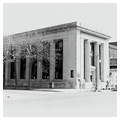Cape Charles was created in 1884 as the southern terminus of the Eastern Shore's first railroad, the New York, Philadelphia and Norfolk (NYP&N), owned by William Lawrence Scott and Alexander Cassatt (later president of the Pennsylvania Railroad). From Cape Charles, barges would carry railroad cars across the Chesapeake Bay to Norfolk. The harbor was dredged and the town laid out. Civil engineer William Bauman planned the town on a grid pattern with twenty-seven rectangular and square blocks formed by six north-south streets named for fruits and seven east-west streets named for Virginia statesmen. In the center of the grid is a park (now fenced). The main business street, Mason Avenue, is at the southern edge, fronting on the railroad, barge yards, and waterfront. Rail and barge traffic began to decline after World War II, and today service is limited. The town retains much of its earlier character.
The main architectural landmark of Cape Charles is the Water Tower (c. 1985), which imitates a large lighthouse. At the corner of Mason Avenue and Fig Street is an amazing survivor, the Jacobean Revival Kellogg Building (
ES2.1) (c. 1926), a former automobile dealership and attached gas station constructed of tan and brown brick. You fill your car with gas in front of gables remindful of Bacon's Castle. Farther down Mason Avenue, at the corner of Peach Street, is another survivor of the hundreds of Pure Oil service stations that used to dot the East Coast (1930, Carl A. Peterson). (A Pure Oil in ruins is on Virginia 184.) Designed in the English “cottage style,” they were built in the 1920s and 1930s and were instantly recognizable by their blue tile roofs and trim. Peach Street, a boulevard, is the town's north-south axis. Two banks occupy the next corner, at Mason Avenue and Pine Street. The town's largest and most impressive building is the Sovran Bank (formerly the Northampton County Trust Bank) (
ES2.2) (1921, Wyatt and Nolting), a Neoclassical Revival building with engaged in antis colonnade in a colossal Ionic order and full entablature. On the opposite corner is the Colonial Revival Mumford Bank (
ES2.3) (1895, W. H. Lambertson), in tan brick
The residential area to the north of Mason Avenue dates from 1884 to 1920 and is composed of a variety of Queen Anne, Colonial Revival, bungaloid, and Foursquare houses. The area is a historic district, and many houses display plaques with dates. Reputedly many of the houses are Sears, Roebuck mail order, but this origin has not been confirmed. Bay Avenue, at the end of Mason Avenue and fronting on the bay, was the elite address and has the most impressive houses. The A. L. Detwiler House (1919, Charles Weber Bolton of Philadelphia), 212 Bay Avenue, is a large Colonial Revival house. The Jack V. Moore House (1909, William Newton Diehl of Norfolk), 306 Bay Avenue, is in the Southern Colonial Revival mode, with a giant portico. The Pavilion (1923), on Bay Avenue opposite the termination of Randolph Avenue, is a simple octagonal frame gazebo, built by a local contractor, Conrad Grimmer.






